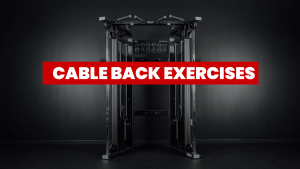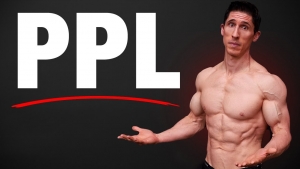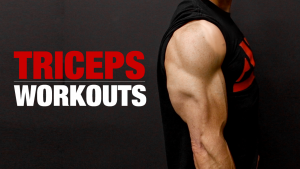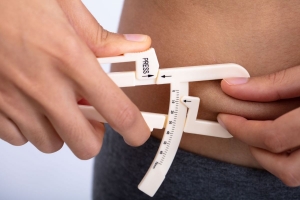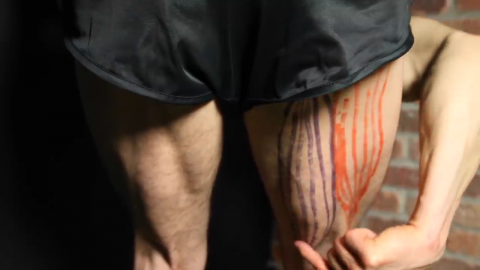
WHY THE CABLE PULL THROUGH?
Ready to build serious glute strength and maximize muscle hypertrophy?
The Cable Pull Through is your go-to exercise for targeting the posterior chain with precision.
Unlike Deadlifts or other advanced hip hinge variations, the Cable Pull-Through isolates your glutes and hamstrings, enhancing muscle tension and lengthening without overloading your spine.
Using the cable pulley machine and rope attachment, this movement taps into the full range of muscle spindles, improving hamstring activation, mobility, and strength reflexes during training.
Every rep builds max strength, improves hinge mechanics, and challenges you to maintain foot pressure and posture throughout.
Whether you’re working with heavy weight, midrange weight, or exploring Cable Pull-Through alternatives, this exercise is a functional powerhouse for any strength athlete.
It’s the ultimate move to address strength imbalances, boost hamstring flexibility, and keep those gains coming.
Grab that tricep rope attachment and let’s learn this essential piece of your leg day workout!
CABLE PULL THROUGH: MUSCLES WORKED
If you’re looking to build serious glute and hamstring strength, the Cable Pull Through is the exercise you need in your routine.
This isn’t just another hip hinge exercise—it’s a targeted muscle-building machine that isolates your posterior chain like no other.
Deadlifts or Kettlebell Swings can overload the spine, but the Cable Pull Through keeps your spine neutral, allowing you to hammer your glutes and hamstrings safely and effectively.
Got strength imbalances? The Cable Pull Through addresses them head-on.
It’s an important exercise for posterior chain strength and perfect for anyone tired of relying on quad-dominant exercises.
With each rep, you’re building not just body strength but also grip strength, eccentric strength, and overall muscle activation in the posterior muscles.
But let’s get one thing straight: Proper mechanics are non-negotiable.
And one of the best ways to learn proper form is to understand the muscles that are being worked.
Let’s take a closer look at the primary muscle groups involved in the Cable Pull Through.
GLUTES
The glutes muscles are the powerhouse of your lower body, driving strength, stability, and explosive movement.
Mastering exercises like the Cable Pull-Through targets these muscles directly, enhancing both aesthetics and performance.
GLUTEUS MAXIMUS
When you think glutes, you’re thinking gluteus maximus—the muscle that gives your butt its shape and, more importantly, its power.
Originating from the hip bone and lower spine (sacrum and coccyx), it connects to the iliotibial tract and thigh bone, powering movements that define your workouts.
Here are some of the key functions of the gluteus maximus:
Hip Extension: The gluteus maximus drives hip extension, crucial in exercises like Deadlifts, Romanian Deadlifts, Cable Pull-Throughs, and Kettlebell Swings. It’s all about intense muscle contraction and muscle activation to boost muscle growth and strength.
Lateral Rotation and Stability: This muscle rotates the thigh outward, stabilizing the hip joint during exercises. Whether it’s heavy deadlifts or Cable Hip Extension, proper mechanics and muscle engagement are essential.
Thigh Abduction: Aids in moving the thigh away from the midline during hip flexion, working hard in movements like Paused Cable Pull-Throughs and other hip hinge exercises.
Posture and Sacroiliac Stability: Supports upright posture and stabilizes the sacroiliac joint, essential for protecting the spine during weight-loaded movements, reducing muscle damage and strength imbalances.
GLUTEUS MEDIUS
The gluteus medius might not get the spotlight like the gluteus maximus, but it’s a powerhouse for hip stability, strength, and balance.
This muscle starts on the outer surface of the pelvis, right below the iliac crest, and inserts on the greater trochanter of the femur—the bony protrusion on the thigh.
It’s the muscle that keeps your body strong, stable, and injury-free during your workouts.
Hip Abduction: The primary job of the gluteus medius is hip abduction—moving your thigh away from your body. It’s crucial for activities like walking, running, and even during complex exercises like Cable Pull Throughs and Hip Extension exercises. Proper mechanics here translate to more solid muscle and strength gains.
Rotation of the Hip: The gluteus medius handles both medial and lateral rotation, depending on the thigh position. This is critical for muscle engagement during awkward exercises and helps maintain the correct range of motion in movements like Romanian Deadlifts and Kettlebell Swings.
Pelvic Stability: This muscle keeps your pelvis level, especially when standing on one leg, making it essential for movement mechanics and injury prevention. If you’re doing strength training or loading weight with heavy Deadlifts, the gluteus medius is what keeps you grounded and your spine neutral.
Posture and Balance: Beyond muscle activation and muscle building, the gluteus medius plays a big role in posture maintenance. Strong glutes mean a stronger core and posterior chain strength, helping you stay balanced and powerful during any exercise, from band tension work to eccentric strength training.
GLUTEUS MINIMUS
The gluteus minimus might be the smallest of the glute muscles, but don’t underestimate its role in hip function and stability.
It supports everything from muscle activation to overall glute muscle growth.
This muscle starts from the lower portion of the pelvic bone and attaches to the front of the greater trochanter on your femur.
Even though it’s tucked beneath the gluteus medius, it packs a punch when it comes to stability and movement mechanics.
Hip Abduction: The gluteus minimus works like a sidekick to the gluteus medius, driving hip abduction. This action is crucial for balance during walking, running, and any exercise that requires stability. It’s especially active in movements like Cable Pull Throughs, Cable Hip Extension, and hip hinge exercises, where muscle engagement is key.
Medial Rotation of the Hip: When your hip is flexed, the gluteus minimus assists in medial rotation, turning the thigh inward. This is important during exercises like Paused Cable Pull Throughs, where maintaining proper mechanics and a neutral spine are essential for muscle building and avoiding muscle damage.
Pelvic Stability: The gluteus minimus plays a critical role in stabilizing the pelvis, especially when standing on one leg. This stability is vital for strength athletes and those working on posterior chain strength, helping to address strength imbalances and boost overall body strength during leg day workouts.
Posture and Core Support: By enhancing pelvic stability, the gluteus minimus also contributes to posture maintenance. It works in tandem with your core muscles, glutes, and posterior muscles to support your spine during strength training, from heavy Deadlifts to Kettlebell Swings.
HAMSTRINGS
The hamstrings muscles play a crucial role in supporting your lower body strength, speed, and injury prevention.
The Cable Pull-Through is an excellent exercise to engage and develop these muscles, boosting your overall leg power and mobility.
BICEPS FEMORIS
The biceps femoris is one of the key muscles that make up your hamstrings, running along the back of your thigh and playing a critical role in both athletic performance and functional movement.
Originating from the ischial tuberosity of the hip bone and the femur, it inserts at the head of the fibula, making it essential for knee and hip actions.
Here are some of the key functions of the biceps femoris:
Hip Extension: The biceps femoris, along with the gluteus maximus, drives hip extension during movements like Deadlifts, Cable Pull-Throughs, and Kettlebell Swings. This muscle engagement helps increase power, stability, and muscle growth during lower body exercises.
Knee Flexion: This muscle bends the knee, working intensely during actions like leg curls or the lowering phase of squats, and provides essential support during the cable pull-through by controlling the knee position.
Lateral Rotation of the Knee: Assists in rotating the knee outward when it’s flexed, contributing to overall lower body coordination and stability during dynamic movements, ensuring efficient muscle activation during each pull-through repetition.
Postural Support and Lower Body Alignment: Provides stability for the hip and knee joints, critical for maintaining correct form in cable pull-throughs, preventing strength imbalances and optimizing performance while minimizing injury risk.
SEMITENDINOSUS
The semitendinosus is a key muscle within the hamstring group, running along the inner side of the back of your thigh. It plays a crucial role in leg movement, flexibility, and stability, making it an important muscle for both athletic performance and everyday activities.
Originating from the ischial tuberosity of the hip, it inserts into the tibia, directly influencing knee and hip mechanics.
Hip Extension: Working alongside the biceps femoris and gluteus maximus, the semitendinosus powers hip extension during exercises like Cable Pull-Throughs, Deadlifts, and Hip Thrusts. Its activation boosts lower body power and muscle development, particularly in hip hinge movements.
Knee Flexion and Internal Rotation: The semitendinosus bends the knee and helps rotate it inward, enhancing control and stability during dynamic exercises. This function is crucial during the cable pull-through, as it maintains knee alignment and supports balanced muscle activation.
Medial Rotation of the Hip: This muscle contributes to rotating the thigh inward, aiding in stabilizing the hip during lower body movements. Proper activation of the semitendinosus ensures smooth, controlled transitions through each phase of the Cable Pull-Through.
Postural Stability and Joint Support: The semitendinosus stabilizes the pelvis and knee joint, protecting against overextension and imbalance. Its engagement in the Cable Pull-Through helps maintain form, reducing the risk of injury while maximizing muscle efficiency.
HOW TO DO THE CABLE PULL THROUGH
Mastering the Cable Pull-Through will dramatically help with building glute and hamstring strength.
This exercise isolates your posterior chain, maximizes muscle activation, and perfects your hip hinge mechanics—all while minimizing strain on your lower back.
Follow these steps to get the most out of this essential movement and elevate your strength training routine.
CABLE PULL THROUGH


HOW TO DO THE CABLE PULL THROUGH:
- Set up the cable machine with a rope attachment at the lowest setting. Choose a weight that challenges your muscle reflex without compromising form—this is crucial for muscle response and proper muscle lengthening.
- Face away from the cable machine with your feet flat, slightly wider than hip-width. This stance activates those big posterior muscles, targeting the glutes and hamstrings for maximum muscle engagement.
- Reach down, grab the rope handles between your legs with straight arms, and make sure your deep spine is neutral. Keep your knees slightly bent and aligned with your hips.
- Engage your core and hinge at the hips, letting the cable pull your torso down. This isn’t about speed; it’s about control, muscle tension, and time under tension. Feel the muscle spindles firing as your glute and hamstring stretch, especially if you’ve got tight hamstrings.
- Drive through your entire foot and squeeze your glutes hard as you pull the cable back up, extending your hips fully but avoiding overextending your spine. Keep your foot pressure consistent—push through your heels to hammer those glutes.
- Lower back down into the hinge, maintaining tension on the cable the entire time. This constant load helps increase posterior strength and boosts your hamstring training volume.
WHAT MAKES IT EFFECTIVE: The Cable Pull-Through is the queen of compound exercises for a reason. It’s a great movement for strength athletes and anyone dealing with lots of hamstrings muscle imbalances or needing that extra mobility work. The Cable Pull-Through reduces unnecessary strain while targeting the full range of muscle activation, making it a top-tier functional exercise.
CABLE PULL THROUGH: COMMON MISTAKES
Don’t let bad form ruin your gains.
The Cable Pull-Through is excellent for posterior strength, but only if you nail the mechanics.
Here are the most common mistakes for the Cable Pull Through and how to fix them.
ROUNDING THE BACK
One of the biggest mistakes is letting your spine round during the movement.
This turns the Cable Pull-Through into a disaster waiting to happen.
Keep your back flat and hinge at the hips, not your lower back.
Your spine should stay neutral from start to finish, just like when you’re setting up for a Deadlift.
This isn’t just a basic Deadlift for people—it’s precision training that demands proper form.
IMPROPER FOOT POSITIONING
Your feet are the foundation of this exercise.
If they’re too close or too far apart, you’re not hitting the right ranges of muscle activation.
Keep your stance slightly wider than hip-width with consistent foot pressure.
This setup activates the fullest ranges of your glutes and hamstrings, ensuring you’re maximizing muscle engagement.
USING TOO MUCH WEIGHT
More weight isn’t always better, especially if it compromises your form.
You’re not here to max out cable stacks; you’re here to activate muscles.
Start with a weight that allows for full range of motion without sacrificing control.
This isn’t about how much you can pull—focus on time under tension and proper muscle response.
LACK OF HIP HINGE MECHANICS
Hinging at the hips is key, not just bending over.
If you’re bending your knees too much, you’re turning this exercise into Hamstring Curls, missing the target on those glutes and hamstring mobility.
Think of the hinge like an advanced Deadlift movement that demands control, stability, and precision.
OVEREXTENDING AT THE TOP
A big mistake is thrusting your hips too far forward, overextending your lower back.
Remember, you’re aiming for glute engagement, not lower back strain.
Squeeze your glutes at the top without hyperextending. Your goal is muscle activation, not injuries over time.
RUSHING THE MOVEMENT
This isn’t a race. Don’t rush the reps.
Focus on controlled, deliberate movements that engage your muscles fully.
Feel the stretch as you hinge back and the squeeze as you drive up.
The Cable Pull-Through increases effectiveness when you take your time, allowing for reflex during strength training and targeting the muscles across the entire range.
The Cable Pull Through emphasizes full hip extension, activates the glutes like no other, and is perfect for advanced Deadlift variations and Deadlift technique refinement.
Whether you’re looking to boost your endurance weight training or just need a 7-minute glutes workout, this move delivers serious posterior strength gains.
If you’re looking for a training program that covers every muscle in the body, we’ve got you covered. Check out our ATHLEAN-X programs to see which is the best fit for your goals and fitness level.

- The Cable Pull-Through is a great functional exercise that targets full muscle activation, corrects hamstring imbalances, enhances mobility, and minimizes unnecessary strain, making it essential for strength athletes.
- Here’s how to perform the Cable Pull Through with perfect form:
- Start by setting the cable machine to the lowest setting and attach a rope handle. Choose a weight that challenges you but still allows for full control—you’re not here to max out cable stacks. You’re here to work those glutes.
- Stand facing away from the cable machine with your feet slightly wider than hip-width apart. Keep your feet flat and pressure consistent from heel to toe.
- Reach down and grab the rope attachment with both hands, arms straight between your legs. Your palms should face each other. Keep your spine neutral—think of your back as a straight line from your head to your hips.
- With your core tight, push your hips back as far as possible, letting the cable pull your arms and torso towards the floor. This isn’t a squat; it’s a hinge, just like an advanced Deadlift movement.
- Once you reach the bottom, drive through your entire foot and pull your hips forward, squeezing your glutes hard at the top. Don’t overextend your lower back—keep the movement controlled. This is where muscle activation happens.
- Hinge back down, keeping tension on the cable throughout. Focus on muscle lengthening during the lowering phase. This controlled movement keeps your glutes and hamstrings fully engaged and primed for muscle growth.
CABLE PULL THROUGHS FAQ
Cable Pull-Throughs are an excellent move that zeroes in on your entire posterior chain—mainly hitting the glutes, hamstrings, and lower back.
Think of it as a combination of strength, stability, and muscle activation all in one.
Unlike simply loading up on weights or throwing weight plates around, this exercise uses the cable machine to create constant tension that isolates those key muscles.
Glutes: The main target here is your glutes, making them work through the full hip extension. This is where you get that intense muscle engagement and glute growth. It’s not just about pulling weight; it’s about activating your glutes through every inch of the movement.
Hamstrings: Your hamstrings are working hard, especially during the hinge portion of the movement. This move makes your hamstrings stretch and contract under controlled tension, which is necessary for proper muscle activation. Time to wake up those hamstrings.
Lower Back: While the focus is on your glutes and hamstrings, your lower back is also stabilizing throughout the entire range. But don’t worry; this isn’t about putting your back at risk like with heavy weight plates—it’s about controlled strength that keeps your spine neutral and safe.
And if you’re wondering if you can swap in proper resistance bands or a thicker resistance band, sure—you’ll get similar benefits, but the Cable Pull-Throughs give you that electric ranges of constant tension that bands can’t match.
Absolutely. The Cable Pull-Through isn’t just worth it—it’s a must for anyone serious about building glute and hamstring strength.
This move targets the entire posterior chain with laser precision, isolating the muscles that get overlooked in typical weight plate-heavy exercises like Deadlifts.
What makes it different? It’s all about constant tension.
With the cable machine, you’re not just moving weights up and down; you’re engaging muscles across the entire range of motion, maximizing muscle activation and muscle hypertrophy without putting your spine at risk.
You can’t replicate that kind of muscle engagement with just a barbell or even a proper resistance band.
100% yes. If you're looking to build bigger, stronger glutes, the Cable Pull-Through should be a go-to in your workout arsenal.
This exercise is designed to hit your glutes hard by isolating them with constant tension throughout the entire movement.
Here’s why it works:
Cable Pull-Throughs maximize glute activation by focusing on hip extension, which is the primary function of your glute muscles.
You’re not just moving weights—you’re engaging your glutes in every inch of the motion, creating intense muscle tension and the perfect stimulus for muscle growth.
And because the cable keeps tension on the glutes the entire time, you get that extra muscle-building edge.
Not even close. While both the Cable Pull-Through and Romanian Deadlift (RDL) are hip hinge exercises that target the posterior chain, they’re not interchangeable—and knowing the difference can make or break your gains.
Cable Pull-Throughs are all about glute isolation and controlled muscle activation.
With the cable pulley machine, you’ve got constant tension throughout the entire range of motion, especially on the glutes, making this exercise perfect for targeting muscle hypertrophy without overloading your lower back.
RDLs, on the other hand, are more of a full-body challenge, with the hamstrings, glutes, and even your lower back getting in on the action.
You’re working with free weights or weight plates, focusing on eccentric control and time under tension to build posterior strength.
But here’s the catch: if your form slips, you risk turning this exercise into a lower back workout instead of a glute builder.
REFERENCES

Jeff Cavaliere M.S.P.T, CSCS
Jeff Cavaliere is a Physical Therapist, Strength Coach and creator of the ATHLEAN-X Training Programs and ATHLEAN-Rx Supplements. He has a Masters in Physical Therapy (MSPT) and has worked as Head Physical Therapist for the New York Mets, as well as training many elite professional athletes in Major League Baseball, NFL, MMA and professional wrestling. His programs produce “next level” achievements in muscle size, strength and performance for professional athletes and anyone looking to build a muscular athletic physique.






